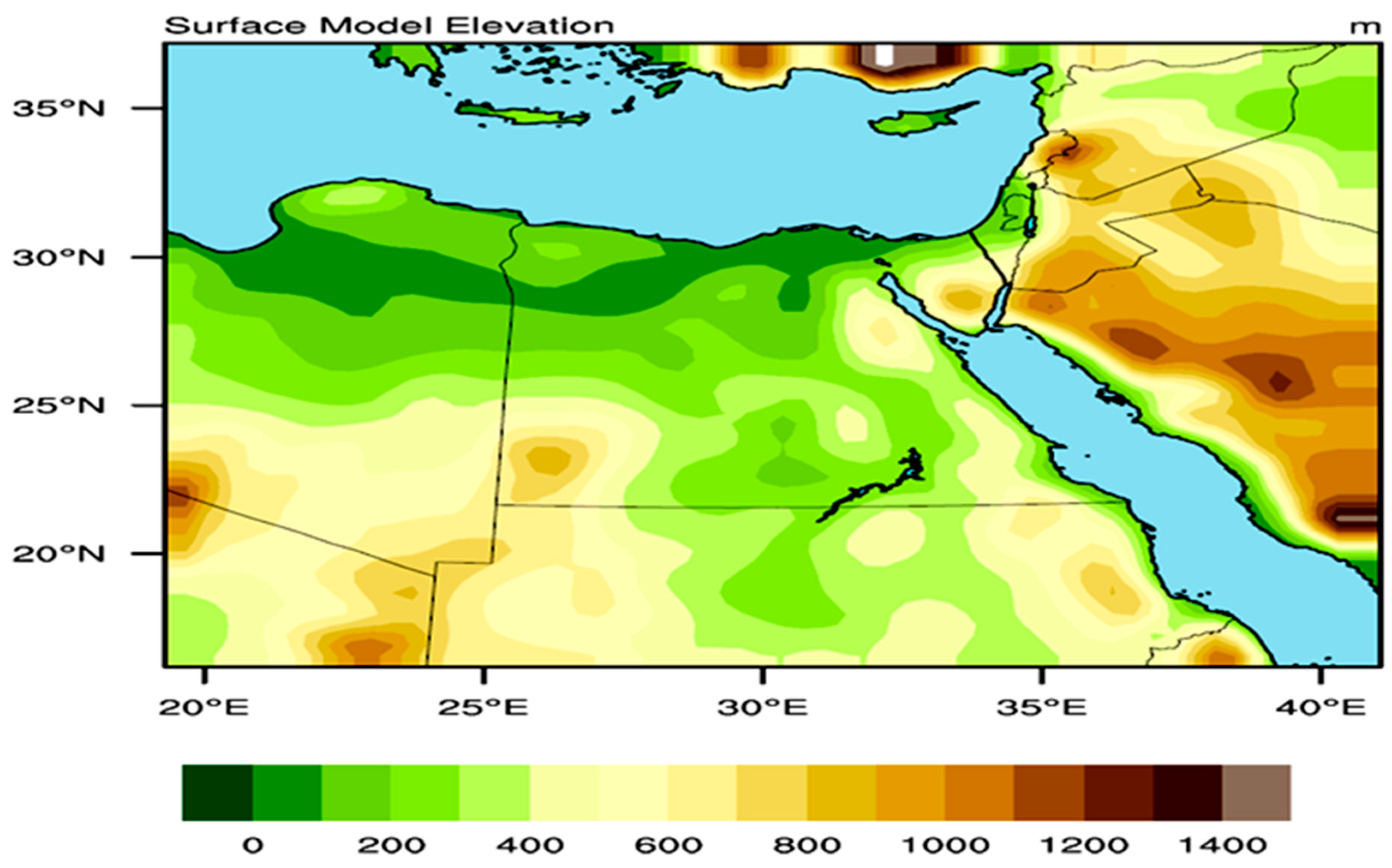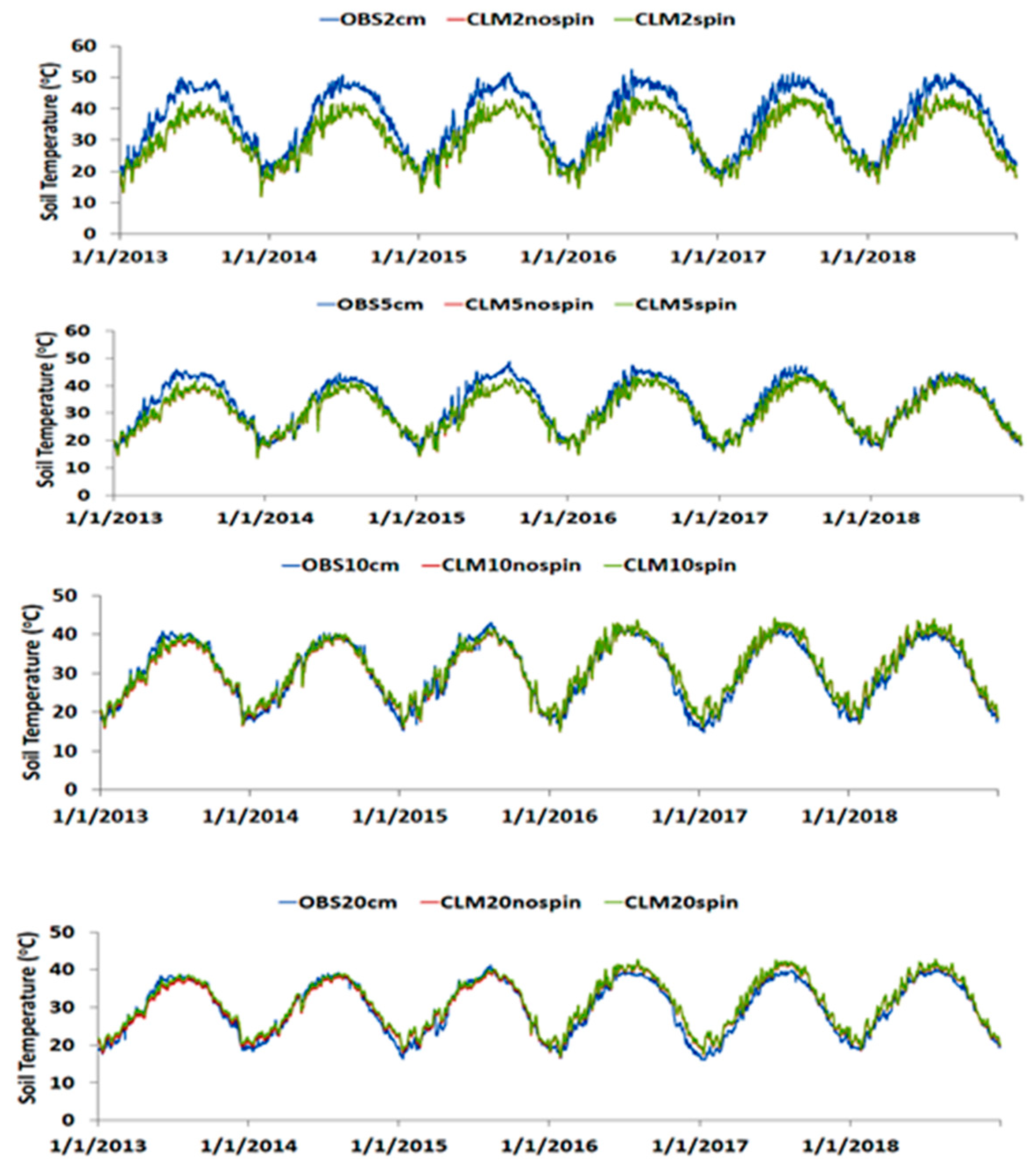The Influence of Different Initial Conditions on the Soil Temperature Profile of Egypt Using a Regional Climate Model †
Abstract
1. Introduction
- Modify the Community Land Model (CLM45; which is coupled to the RegCM4) to properly simulate the daily soil temperature profile of Egypt.
- Adapt a spin-up procedure to initialize the regional coupled RegCM4-CLM45 model with a good initial condition of the soil temperature.
2. Materials and Methods
2.1. Model Description and Experiment Design
- Spin-up phase: In this phase, the model was driven with the climatological mean of the EIN15 (EIXXX) to eliminate climate trends and inter-annual variability. To approach the equilibrium state (for shallow and deep depths), the model needs to cycle through the EIXXX 150 times.
- Experiment phase: To initialize this phase, the last file from the spin-up phase was interpolated on the first restart file (from the real simulation) using the interpinic. Interpinic is an executable program (provided by the offline CLM45 land surface model) and was originally created for interpolating the CLM restart file from one resolution to another.
2.2. Validation Data
3. Results
3.1. Spin-Up Phase
3.2. Experiment Phase
4. Discussion and Conclusions
- Incorporating a high-resolution soil map of Egypt into the global static dataset (to account for the local soil features), which considerably affects the heat transfer in soil from one layer to another.
- Implementing a numerical scheme to reduce the spin-up time of deep soil depths.
Supplementary Materials
Author Contributions
Funding
Institutional Review Board Statement
Informed Consent Statement
Data Availability Statement
Acknowledgments
Conflicts of Interest
References
- Mavi, H.S.; Tupper, G.S. Agrometeorology: Principles and Applications of Climate Studies in Agriculture; CRC Press: Binghamton, NY, USA, 2004. [Google Scholar]
- Bonan, G. Ecological Climatology: Concepts and Applications, 3rd ed.; Cambridge University Press: Cambridge, UK, 2005. [Google Scholar] [CrossRef]
- Xia, Y.; Ek, M.; Sheffield, J.; Livneh, B.; Huang, M.; Wei, H.; Feng, S.; Luo, L.; Meng, J.; Wood, E. Validation of Noah-Simulated Soil Temperature in the North American Land Data Assimilation System Phase 2. J. Appl. Meteorol. Climatol. 2012, 52, 455–471. [Google Scholar] [CrossRef]
- Zhu, J.; Liang, X.-Z. Regional climate model simulation of U.S. soil temperature and moisture during 1982–2002. J. Geophys. Res. Atmos. 2005, 110. [Google Scholar] [CrossRef]
- Giorgi, F.; Coppola, E.; Solmon, F.; Mariotti, L.; Sylla, M.B.; Bi, X.; Elguindi, N.; Diro, G.T.; Nair, V.; Giuliani, G.; et al. RegCM4: Model description and preliminary tests over multiple CORDEX domains. Clim. Res. 2012, 52, 7–29. [Google Scholar] [CrossRef]
- Oleson, K.; Lawrence, D.M.; Bonan, G.B.; Drewniak, B.; Huang, M.; Koven, C.D.; Yang, Z.-L. Technical Description of Version 4.5 of the Community Land Model (CLM); No. NCAR/TN-503+STR; NCAR: Boulder, CO, USA, 2013. [Google Scholar] [CrossRef]
- Dee, D.P.; Uppala, S.M.; Simmons, A.J.; Berrisford, P.; Poli, P.; Kobayashi, S.; Andrae, U.; Balmaseda, M.A.; Balsamo, G.; Bauer, P.; et al. The ERA-Interim reanalysis: Configuration and performance of the data assimilation system. Q. J. R. Meteorol. Soc. 2011, 137, 553–597. [Google Scholar] [CrossRef]
- Hersbach, H.; Bell, B.; Berrisford, P.; Hirahara, S.; Horányi, A.; Muñoz-Sabater, J.; Nicolas, J.; Peubey, C.; Radu, R.; Schepers, D.; et al. The ERA5 global reanalysis. Q. J. R. Meteorol. Soc. 2020, 146, 1999–2049. [Google Scholar] [CrossRef]
- Saito, H.; Simunek, J.; Mohanty, B.P. Numerical analysis of coupled water, vapor, and heat transport in the Vadose Zone. Vadose Zone J. 2006, 5, 784–800. [Google Scholar] [CrossRef]



| Station Name | Latitude | Longitude | Available Soil Depths | Available Period |
|---|---|---|---|---|
| Assyut | 27.2 | 31.16 | 2, 5, 10, 20, 50 100, and 200 cm | 2013–2018 |
| Kharga | 25.45 | 30.53 | 2, 5, 10, 20, 50, 100, and 200 cm | 2012–2018 |
| Tahrir | 30.65 | 30.7 | 2, 5, 10, 20, 50, 100, and 200 cm | 2012–2018 |
| Malawi | 27.7 | 30.75 | 2, 5, 10, 20, 50, and 100 cm | 2012–2018 |
Disclaimer/Publisher’s Note: The statements, opinions and data contained in all publications are solely those of the individual author(s) and contributor(s) and not of MDPI and/or the editor(s). MDPI and/or the editor(s) disclaim responsibility for any injury to people or property resulting from any ideas, methods, instructions or products referred to in the content. |
© 2022 by the authors. Licensee MDPI, Basel, Switzerland. This article is an open access article distributed under the terms and conditions of the Creative Commons Attribution (CC BY) license (https://creativecommons.org/licenses/by/4.0/).
Share and Cite
Anwar, S.A.; Hejabi, S. The Influence of Different Initial Conditions on the Soil Temperature Profile of Egypt Using a Regional Climate Model. Eng. Proc. 2023, 31, 62. https://doi.org/10.3390/ASEC2022-13850
Anwar SA, Hejabi S. The Influence of Different Initial Conditions on the Soil Temperature Profile of Egypt Using a Regional Climate Model. Engineering Proceedings. 2023; 31(1):62. https://doi.org/10.3390/ASEC2022-13850
Chicago/Turabian StyleAnwar, Samy A., and Somayah Hejabi. 2023. "The Influence of Different Initial Conditions on the Soil Temperature Profile of Egypt Using a Regional Climate Model" Engineering Proceedings 31, no. 1: 62. https://doi.org/10.3390/ASEC2022-13850
APA StyleAnwar, S. A., & Hejabi, S. (2023). The Influence of Different Initial Conditions on the Soil Temperature Profile of Egypt Using a Regional Climate Model. Engineering Proceedings, 31(1), 62. https://doi.org/10.3390/ASEC2022-13850







